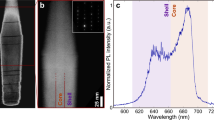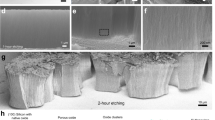Abstract
Controlled growth of nanowires is an important, emerging research field with many applications in, for example, electronics, photonics, and life sciences. Nanowires of zinc blende crystal structure, grown in the 〈111〉B direction, which is the favoured direction of growth, usually have a large number of twin-plane defects. Such defects limit the performance of optoelectronic nanowire-based devices. To investigate this defect formation, we examine GaP nanowires grown by metal-organic vapour-phase epitaxy. We show that the nanowire segments between the twin planes are of octahedral shape and are terminated by {111} facets, resulting in a microfaceting of the nanowires. We discuss these findings in a nucleation context, where we present an idea on how the twin planes form. This investigation contributes to the understanding of defect formation in nanowires. One future prospect of such knowledge is to determine strategies on how to control the crystallinity of nanowires.
This is a preview of subscription content, access via your institution
Access options
Subscribe to this journal
Receive 12 print issues and online access
$259.00 per year
only $21.58 per issue
Buy this article
- Purchase on Springer Link
- Instant access to full article PDF
Prices may be subject to local taxes which are calculated during checkout





Similar content being viewed by others
References
Samuelson, L. et al. Semiconductor nanowires for 0D and 1D physics and applications. Physica E 25, 313–318 (2004).
Cui, Y., Zhong, Z., Wang, D., Wang, W. & Lieber, C. High performance silicon nanowire field effect transistors. Nano Lett. 3, 149–152 (2003).
Thelander, C. et al. Single-electron transistors in heterostructure nanowires. Appl. Phys. Lett. 83, 2052–2054 (2003).
Varfolomeev, A., Pokalyakin, V., Tereshin, S., Zaretsky, D. & Bandyopadhyay, S. Switching time of nanowire memory. J. Nanosci. Nanotechnol. 5, 753–758 (2005).
Mårtensson, T. et al. Epitaxial III-V nanowires on silicon. Nano Lett. 4, 1987–1990 (2004).
Evoy, S. et al. Dielectrophoretic assembly and integration of nanowire devices with functional CMOS operating circuitry. Microelectron. Eng. 75, 31–42 (2004).
Davidson, F. M., Wiacek, R. & Korgel, B. A. Supercritical fluid-liquid-solid synthesis of gallium phosphide nanowires. Chem. Mater. 17, 230–233 (2005).
Verheijen, M. A., Immink, G., de Smet, T., Borgström, M. T. & Bakkers, E. P. A. M. Growth kinetics of heterostructured GaP-GaAs nanowires. J. Am. Chem. Soc. 128, 1353–1359 (2006).
Bhunia, S. et al. Vapor-liquid-solid growth of vertically aligned InP nanowires by metalorganic vapor phase epitaxy. Thin Solid Films 464–465, 244–247 (2004).
Li, Q. et al. Size-dependent periodically twinned ZnSe nanowires. Adv. Mater. 16, 1436–1440 (2004).
Chen, H. et al. Transmission electron microscopy study of pseudoperiodically twinned Zn2SnO4 nanowires. J. Phys. Chem. B 109, 2573–2577 (2005).
Zhou, G. W. & Zhang, Z. Transmission electron microscopy study of Si nanowires. Appl. Phys. Lett. 73, 677–679 (1998).
Zhou, G. W., Zhang, Z. & Yu, D. Growth morphology and micro-structural aspects of Si nanowires synthesized by laser ablation. J. Cryst. Growth 197, 129–135 (1999).
Ross, F., Tersoff, J. & Reuter, M. Sawtooth faceting in silicon nanowires. Phys. Rev. Lett. 95, 146104 (2005).
Schubert, L. et al. Silicon nanowhiskers grown on <111> Si substrates by molecular-beam epitaxy. Appl. Phys. Lett. 84, 4968–4970 (2004).
Hurle, D. T. J. A mechanism for twin formation during Czochralski and encapsulated vertical Bridgeman growth of III-V compound semiconductors. J. Cryst. Growth 147, 239–250 (1995).
Wacaser, B. A., Deppert, K., Karlsson, L. S., Samuelson, L. & Seifert, W. Growth and characterization of defect free GaAs nanowires. J. Cryst. Growth 287, 504–508 (2006).
Heddle, M. F. The geognosy and mineralogy of Scotland. Miner. Mag. 5, 271–324 (1884).
Holt, D. B. Polarity reversal and symmetry in semiconducting compounds with the sphalerite and wurtzite structures. J. Mater. Sci. 19, 439–446 (1984).
Chen, T. P. et al. Study of twins in GaAs, GaP and InAs crystals. J. Cryst. Growth 118, 109–116 (1992).
Cohen, D., McKernan, S. & Carter, C. Characterization of the absolute crystal polarity across twin boundaries in gallium phosphide using convergent-beam electron diffraction. Microsc. Microanal. 5, 173–186 (1999).
Mikkelsen, A. et al. Direct imaging of the atomic structure inside a nanowire by scanning tunnelling microscopy. Nature Mater. 3, 519–523 (2004).
Björk, M. T. et al. One-dimensional heterostructures in semiconductor nanowhiskers. Appl. Phys. Lett. 80, 1058–1060 (2002).
Markov, I. V. Crystal Growth For Beginners (World Scientific, Singapore, 2003).
Voronkov, V. V. Supercooling at the face developing on a rounded crystalization front. Sov. Phys.-Crystallogr. 17, 807–813 (1973).
Hurle, D. T. J. in Sir Charles Frank 80th Birthday Tribute (eds Chambers, R. G., Enderby, J., Keller, A., Lang, A. R. & Steeds, J. W.) 188–206 (Hilger, Bristol, 1991).
van Bueren, H. G. Imperfections in Crystals (North Holland, Amsterdam, 1960).
Gottschalk, H., Patzer, G. & Alexander, H. Stacking-fault energy and ionicity of cubic-III-V compounds. Phys. Status Solidi A 45, 207–217 (1978).
Johansson, J., Svensson, C. P. T., Mårtensson, T., Samuelson, L. & Seifert, W. A mass transport model for semiconductor nanowire growth. J. Phys. Chem. B 109, 13567–13571 (2005).
Takeuchi, S. & Suzuki, K. Stacking fault energies of tetrahedrally coordinated crystals. Phys. Status Solidi A 171, 99–103 (1999).
Krishnamachari, U. et al. Defect-free InP nanowires grown in [001] direction on InP(001). Appl. Phys. Lett. 85, 2077–2079 (2004).
Magnusson, M. H., Deppert, K., Malm, J. O., Bovin, J. O. & Samuelson, L. Gold nanoparticles: production, reshaping, and thermal charging. J. Nanoparticle Res. 1, 243–251 (1999).
Williams, B.D. & Carter, C.B. Transmission Electron Microscopy (Plenum, New York, 1996).
Acknowledgements
This work was carried out within the Nanometer Structure Consortium in Lund and was supported by grants from the Swedish Research Council (VR), the Swedish Foundation for Strategic Research (SSF), the Knut and Alice Wallenberg Foundation, the NoE SANDiE (EU contract No E500101-2), as well as the IP NODE (EU contract No 015783 NODE). We acknowledge R. Wallenberg, A. Mikkelsen, K. Dick, and S. Iyengar for valuable discussions and input to this investigation.
Author information
Authors and Affiliations
Corresponding author
Ethics declarations
Competing interests
The authors declare no competing financial interests.
Rights and permissions
About this article
Cite this article
Johansson, J., Karlsson, L., Patrik T. Svensson, C. et al. Structural properties of 〈111〉B -oriented III–V nanowires. Nature Mater 5, 574–580 (2006). https://doi.org/10.1038/nmat1677
Received:
Accepted:
Published:
Issue Date:
DOI: https://doi.org/10.1038/nmat1677
This article is cited by
-
In-situ growth of heterophase Ni nanocrystals on graphene for enhanced catalytic reduction of 4-nitrophenol
Nano Research (2022)
-
Elastic, Mechanical and Ultrasonic Properties of Nanostructured IIIrd Group Phosphides
MAPAN (2021)
-
Recent advances in nanowire quantum dot (NWQD) single-photon emitters
Quantum Information Processing (2020)
-
Parallel Nanoimprint Forming of One-Dimensional Chiral Semiconductor for Strain-Engineered Optical Properties
Nano-Micro Letters (2020)
-
Influence of Molecular Beam Epitaxy (MBE) Parameters on Catalyst-Free Growth of InAs Nanowires on Silicon (111) Substrate
Journal of Electronic Materials (2019)



